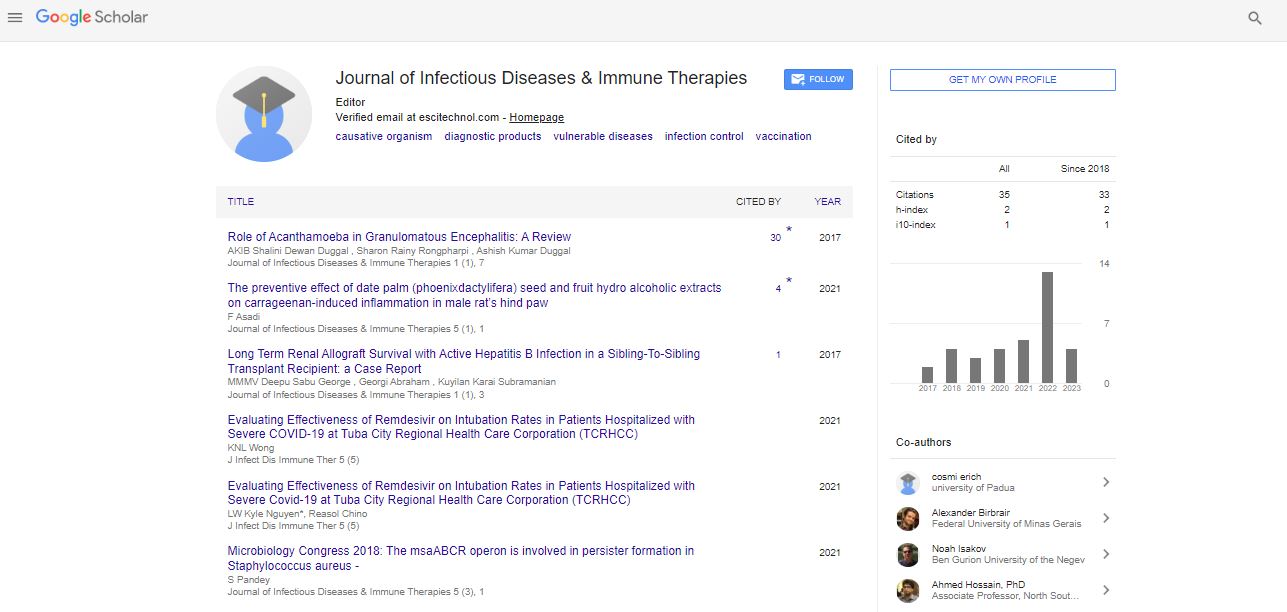Perspective, J Aging Geriatr Med Vol: 7 Issue: 3
Cyto-Megalo Virus Role in Congenital Infections and Birth Defects
Benomar Gale*
1Department of Experimental and Clinical Medicine, University of Florence, Florence, Italy
*Corresponding Author: Benomar Gale,
Department of Experimental and Clinical
Medicine, University of Florence, Florence, Italy
E-mail: benomar.gale@unifi.it
Received date: 28 August, 2023, Manuscript No. JIDITH-23-117447;
Editor assigned date: 30 August, 2023, PreQC No. JIDITH-23-117447 (PQ);
Reviewed date: 13 September, 2023, QC No. JIDITH-23-117447;
Revised date: 21 September, 2023, Manuscript No. JIDITH-23-117447 (R);
Published date: 29 September, 2023, DOI: 10.4172/2329-9541.1000353
Citation: Gale B (2023) Cyto-Megalo Virus Role in Congenital Infections and Birth Defects. J Infect Dis Immune Ther 7:3.
Description
Cyto-Megalo Virus (CMV) is a ubiquitous herpesvirus that often goes unnoticed, yet its impact on human health is profound. Cyto- Megalo Virus (CMV), a member of the herpesviridae family, stands as a testament to the dual nature of many viruses. Ubiquitous and often asymptomatic, CMV coexists with humans for life in a majority of cases. However, for certain populations, such as immunocompromised individuals and neonates, this "silent giant" emerges as a potent pathogen. Understanding the complex and multifaceted nature of CMV is not only a virological endeavor but also a public health imperative. CMV is a large, enveloped, double-stranded DNA virus with a complex structure. It can establish latency, remaining quiescent in the host after primary infection. The virus expresses a variety of genes that manipulate host immune responses and facilitate its persistence. Notably, CMV's wide range of glycoproteins allows it to efficiently enter and exit host cells. CMV is among the most widespread human pathogens. By adulthood, the majority of individuals worldwide have been infected with CMV, often without apparent symptoms. The virus is transmitted through various bodily fluids, including saliva, urine, blood, and breast milk. Primary infection is common in childhood and can result in flu-like symptoms.
Following primary infection, CMV establishes latency, residing within host cells, and often eluding detection by the immune system. Cyto- Megalo Virus (CMV) is a common virus that can play a role in the development of birth defects when a pregnant woman is infected with the virus. CMV is a member of the herpesvirus family and is often referred to as Human Herpes Virus 5 (HHV-5). It's important to understand how CMV can lead to birth defects, the associated risks, and preventive measures. CMV can be transmitted to a developing fetus when a pregnant woman is infected with the virus for the first time (primary infection) or when the virus is reactivated during pregnancy. Transmission can occur through contact with bodily fluids, including urine, saliva, blood, and genital secretions. Primary maternal infections during pregnancy carry a higher risk of transmission to the fetus compared to recurrent infections. When CMV is transmitted to a developing fetus, it is known as congenital CMV infection. This infection can potentially lead to birth defects. Not all infants exposed to CMV during pregnancy will develop birth defects, but the risk is present. The risk of CMV-related birth defects is highest when a pregnant woman is infected with CMV during the first trimester (the first 12 weeks of pregnancy). In such cases, the developing fetus may be at greater risk of developmental issues, hearing loss, and other congenital abnormalities. However, CMV infection at any point during pregnancy can potentially lead to birth defects. While there is no cure for CMV, antiviral medications can help manage active infections, particularly in immunocompromised individuals. Ganciclovir and Val ganciclovir are among the primary drugs used for CMV treatment. However, their use can be associated with side effects and the development of drug resistance.
Conclusion
Cytomegalovirus plays a significant role in congenital infections and birth defects, contributing to hearing loss and developmental issues in affected neonates. Despite its prevalence, CMV remains under-recognized as a public health concern. Increasing awareness, improved diagnostic methods, and preventive strategies are essential to reduce the burden of congenital CMV infections and the associated birth defects. This manuscript underscores the need for continued studies and public health efforts to address this silent but significant threat to prenatal health.
 Spanish
Spanish  Chinese
Chinese  Russian
Russian  German
German  French
French  Japanese
Japanese  Portuguese
Portuguese  Hindi
Hindi 